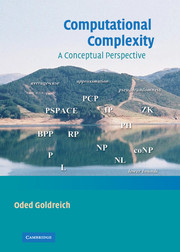Book contents
- Frontmatter
- Contents
- List of Figures
- Preface
- Organization and Chapter Summaries
- Acknowledgments
- 1 Introduction and Preliminaries
- 2 P, NP, and NP-Completeness
- 3 Variations on P and NP
- 4 More Resources, More Power?
- 5 Space Complexity
- 6 Randomness and Counting
- 7 The Bright Side of Hardness
- 8 Pseudorandom Generators
- 9 Probabilistic Proof Systems
- 10 Relaxing the Requirements
- Epilogue
- Appendix A Glossary of Complexity Classes
- Appendix B On the Quest for Lower Bounds
- Appendix C On the Foundations of Modern Cryptography
- Appendix D Probabilistic Preliminaries and Advanced Topics in Randomization
- Appendix E Explicit Constructions
- Appendix F Some Omitted Proofs
- Appendix G Some Computational Problems
- Bibliography
- Index
Organization and Chapter Summaries
Published online by Cambridge University Press: 05 June 2012
- Frontmatter
- Contents
- List of Figures
- Preface
- Organization and Chapter Summaries
- Acknowledgments
- 1 Introduction and Preliminaries
- 2 P, NP, and NP-Completeness
- 3 Variations on P and NP
- 4 More Resources, More Power?
- 5 Space Complexity
- 6 Randomness and Counting
- 7 The Bright Side of Hardness
- 8 Pseudorandom Generators
- 9 Probabilistic Proof Systems
- 10 Relaxing the Requirements
- Epilogue
- Appendix A Glossary of Complexity Classes
- Appendix B On the Quest for Lower Bounds
- Appendix C On the Foundations of Modern Cryptography
- Appendix D Probabilistic Preliminaries and Advanced Topics in Randomization
- Appendix E Explicit Constructions
- Appendix F Some Omitted Proofs
- Appendix G Some Computational Problems
- Bibliography
- Index
Summary
This book consists of ten chapters and seven appendices. The chapters constitute the core of this book and are written in a style adequate for a textbook, whereas the appendices provide either relevant background or additional perspective and are written in the style of a survey article. The relative length and ordering of the chapters (and appendices) do not reflect their relative importance, but rather an attempt at the best logical order (i.e., minimizing the number of forward pointers).
Following are brief summaries of the book's chapters and appendices. These summaries are more novice-friendly than those provided in Section 1.1.3 but less detailed than the summaries provided at the beginning of each chapter.
Chapter 1: Introduction and Preliminaries. The introduction provides a high-level overview of some of the content of Complexity Theory as well as a discussion of some of the characteristic features of this field. In addition, the introduction contains several important comments regarding the approach and conventions of the current book. The preliminaries provide the relevant background on computability theory, which is the setting in which complexity theoretic questions are being studied. Most importantly, central notions such as search and decision problems, algorithms that solve such problems, and their complexity are defined. In addition, this part presents the basic notions underlying non-uniform models of computation (like Boolean circuits).
Chapter 2: P, NP, and NP-Completeness. The P versus NP Question can be phrased as asking whether or not finding solutions is harder than checking the correctness of solutions.
Information
- Type
- Chapter
- Information
- Computational ComplexityA Conceptual Perspective, pp. xvii - xxiiPublisher: Cambridge University PressPrint publication year: 2008
